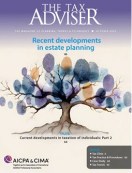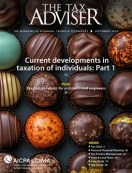- column
- CASE STUDY
Establishing a SIMPLE IRA plan for only a few employees
Related
Premium or paycheck? Tax treatment of secondary sales above FMV
IRS finalizes regulations for Roth catch-up contributions under SECURE 2.0
Proposed regulations issued on retirement catch-up contributions
A SIMPLE IRA plan can be adopted by employers that maintain no other qualified retirement plans and that generally have no more than 100 employees with compensation of $5,000 or more per year. A SIMPLE IRA plan allows employees to make elective salary-deferral contributions to an individual retirement arrangement (IRA), expressed as a percentage of compensation, up to $16,000 per year for 2024 (Secs. 408(p)(2)(A)(i), (ii), and (E); Notice 2023-75). Compensation includes amounts that must be reported by the employer on Form W-2, Wage and Tax Statement, plus any elective contributions from the employee.
SIMPLE IRA plans may allow individuals who have attained at least age 50 by the calendar year end to make additional catch-up contributions (Sec. 414(v)). For 2024, the maximum allowable catch-up contribution is $3,500 (Sec. 414(v)(2)(B)(ii); Notice 2023-75).
Law change: For plan years beginning after Dec. 31, 2024, an increased catch-up contribution will be allowed for years in which the taxpayer is 60–63 at the end of the tax year. For SIMPLE plans, the increased catchup contribution amount would be the greater of $5,000 or 150% of the regular catch-up limit for 2025, indexed for inflation (Sec. 414(v)(2)(E)(ii)).
Each employee who receives at least $5,000 in compensation from the employer during any two prior years and who is reasonably expected to earn at least $5,000 in the current year must be eligible to participate in the SIMPLE IRA plan (Sec. 408(p) (4)(A)). Self-employed individuals are treated as employees for this purpose. Also, leased employees are required to be included if they meet the salary requirements (Sec. 414(m) (4)(B)). Each eligible employee may elect, during the 60-day period before the beginning of any year, to make elective salary-deferral contributions under the SIMPLE IRA plan for that year and to modify any previous elections (Sec. 408(p)(5)(C)). Employees must be allowed to stop making elective contributions at any time during the year. The plan may provide that employees who do so cannot resume them until the beginning of the next year.
Law change: For tax years beginning after Dec. 31, 2022, employees may elect to designate the SIMPLE IRA as a Roth IRA. If this election is made, the contribution is not excludable from income, but later distributions will be tax-free if all other requirements are met (Secs. 402(h)(1) (C) and 408(p)(12)).
Making mandatory employer contributions under a SIMPLE IRA
The employer is required to make payments to each employee’s SIMPLE IRA under one of the following formulas:
- Matching contribution formula: The employer generally is required to match each employee’s elective contributions dollar-for-dollar up to 3% of the employee’s compensation (Sec. 408(p)(2)(A)(iii)). A special rule allows the employer in no more than two out of any five years to elect a lower rate (but not less than 1%) for all employees. The employer must notify employees of the intended rate of match within a reasonable time before the 60-day election period for the year.
- Nonelective contribution formula: The employer is required to make a contribution equal to 2% of compensation on behalf of each eligible employee (regardless of the employee’s salary-deferral contribution, if any). For this purpose, compensation of each eligible employee is limited to $345,000 for 2024 (Sec. 401(a)(17)), thus limiting the contribution to $6,900 per employee ($345,000 × 2%). The employer must notify eligible employees of its intention to use this formula within a reasonable time before the 60-day election period for the year (Sec. 408(p)(2)(B)(i)).
Planning tip: In some cases, a matching contribution can be less expensive for the employer than a nonelective contribution. For example, an employer that has numerous employees who are eligible to participate in its SIMPLE IRA plan but has experienced a low participation rate in prior years will contribute less using the matching formula. If the employer’s principal goal is to maximize contributions to key employees, a matching contribution is also a better choice, regardless of participation rates by lower-paid employees, because more can be contributed to the targeted participants.
Law change: For tax years beginning after Dec. 31, 2023, employers may make additional nonelective contributions to a SIMPLE IRA plan.
Contributions must be made in a uniform manner and may not exceed the lesser of up to 10% of compensation (limited by the Sec. 401(a)(17) limit) or $5,000 (indexed for inflation after 2024) (Sec. 408(p)(2)(A)(iv)).
Employee contribution limits are also increased. For employers with no more than 25 employees, annual elective deferral and catch-up contribution amounts are increased by 10%, as compared with the limit that would otherwise apply. For employers with 26 to 100 employees, higher elective deferral limits are allowed if the employer contributes either 3% of compensation or 4% of an employee’s elective deferrals (Sec. 408(p)(2)(E)(i)).
No other contributions can be made to the SIMPLE IRA plan. Employers must make their matching contributions by the due date (including extensions) of the tax return for the year to which the contributions relate.
Contributions to a SIMPLE IRA plan are deductible by the employer and excluded from the employee’s income (Sec. 402(k)). An employee’s elective salary-deferral contributions are wages for Federal Insurance Contributions Act (FICA) tax purposes, but employer matching contributions are not. Both employee and employer contributions are fully vested when made.
Dealing with SIMPLE IRA administrative requirements
An employer maintaining a SIMPLE IRA plan is not required to file an annual Form 5500, Annual Return/ Report of Employee Benefit Plan, with the IRS or the U.S. Department of Labor. The employer must indicate on Forms W-2 that eligible employees are participants in the plan and indicate the amount of their elective salary-deferral contributions (Sec. 408(l)(2)(A)). The employer is permitted to designate a SIMPLE IRA plan trustee, who is required to (1) provide the employer with a summary description of the plan; (2) provide an account statement to each employee who has a SIMPLE IRA; and (3) file Form 5498, IRA Contribution Information, with the IRS (Secs. 408(i) and (l)(2)(B)).
An employer must notify each employee eligible to participate of the procedures for electing to participate in the plan. This notification must be made before the 60th day before the beginning of the year. An employee who first becomes eligible must be notified within a reasonable time before the 60th day before the first day the employee is eligible to participate (Sec. 401(k)(11)(B)(iii)(II)).
Employers may establish a SIMPLE IRA plan with various financial institutions, mutual fund sponsors, or insurance companies. SIMPLE IRA plans must operate on a calendar year, with a 60-day enrollment period before the beginning of the year. An existing employer may set up a SIMPLE IRA plan between Jan. 1 and Oct. 1 if it did not previously have a SIMPLE IRA plan. If the employer previously maintained a SIMPLE IRA plan, a new plan can be effective only on Jan. 1. A new employer may establish a SIMPLE IRA plan as soon as administratively feasible after starting business (Notice 98-4)
An IRS model plan document, Form 5305-SIMPLE, Savings Incentive Match Plan for Employees of Small Employers (SIMPLE) — for Use With a Designated Financial Institution, may be used to establish a SIMPLE IRA plan. The IRS also provides substantial guidance for establishing a SIMPLE IRA plan (Notice 98-4).
Example. Using a SIMPLE IRA plan to maximize benef its for owners: C Inc. is a calendar-year C corporation owned equally by B and T. Besides these two shareholderemployees, C has three other employees. C normally has low net earnings and is unable to pay a large amount into a retirement plan or be obligated to make a substantial contribution to it. The owners have considered adopting a simplified employee pension (SEP) plan, but they want to contribute a higher percentage of their own salaries than that contributed for the other three employees.
C can adopt a SIMPLE IRA plan. Under the plan, employees can elect to make salary-deferral contributions of up to $16,000 for 2024 (before considering allowable catch-up contributions for employees age 50 and over). C must either (1) match each employee’s contribution up to 3% of the employee’s compensation or (2) make a contribution equal to 2% of each eligible employee’s compensation (regardless of whether the employee made any salary-deferral contribution).
The table “C Inc. Retirement Plan Contributions,” below, shows the results if C adopts a SIMPLE IRA plan for the current year (exclusive of catch-up contributions). It assumes the company chooses to make 3% matching contributions (which would maximize contributions for the two shareholder-employees) and that the three other employees contribute the amounts shown.

Under these assumptions, total retirement plan contributions going to the owners amount to $35,200 ($15,500 + $15,500 + $2,400 + $1,800). Employer contributions for the three other employees are only $2,000 (the matching contributions for J and M). If the corporation instead were to adopt a SEP with a 10% contribution rate, the total cost to the company would be $23,500, with only $14,000 going to the owners and $9,500 going to the other three employees. Thus, there is a distinct advantage to adopting a SIMPLE IRA plan for a small corporation, particularly when many of the rank-and-file employees elect to make lower salary-deferral contributions than those of the shareholder-employees.
The primary disadvantage of a SIMPLE IRA is the lack of flexibility. If the sponsor has an especially profitable year, no more may be contributed to the plan. A plan allowing a larger contribution may not be established because a SIMPLE IRA can be used only when there are no other plans.
SIMPLE 401(k)s of limited value to closely held corporations
SIMPLE 401(k) plans are easier to operate than the typical 401(k) plans, since they do not have to satisfy the detailed nondiscrimination tests that apply to 401(k) plans. Also, the top-heavy rules do not apply. Nevertheless, SIMPLE 401(k) plans are seldom the best plan for a closely held corporation. SIMPLE 401(k) plans are subject to the same filing requirements as regular 401(k) plans, but the contribution limits are much lower and provide limited benefits to highly compensated employees. These plans are also subject to the annual addition limit under Sec. 415.
Contributor
Shannon Christensen, J.D., MBT, is an executive editor with Thomson Reuters Checkpoint. For more information about this column, contact thetaxadviser@ aicpa.org. This case study has been adapted from Checkpoint Tax Planning and Advisory Guide’s Closely Held C Corporations topic. Published by Thomson Reuters, Carrollton, Texas, 2024 (800-431-9025; tax.thomsonreuters.com).














